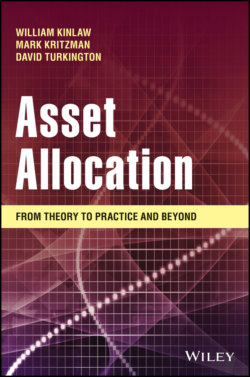Читать книгу Asset Allocation - William Kinlaw, Mark P. Kritzman - Страница 41
EXPECTED UTILITY
ОглавлениеThe addition of an asset class to a portfolio should raise the portfolio's expected utility. This could occur in two ways. First, inclusion of the asset class could increase the portfolio's expected return. Second, its inclusion could lower the portfolio's risk, either because its own risk is low or because it has low correlations with other asset classes in the portfolio.
The expected return and risk properties of an asset class should not be judged only according to their average values across a range of market regimes. A particular asset class such as commodities, for example, might have a relatively low expected return and high risk on average across shifting market regimes, but during periods of high financial turbulence could provide exceptional diversification against financial assets. Given a utility function that exhibits extreme aversion to large losses, which typically occur during periods of financial turbulence, commodities could indeed raise a portfolio's expected utility despite having unexceptional expected return and risk properties on average.
It might occur to you that in order to raise a portfolio's expected utility, an asset class must be externally heterogeneous. This is true. It does not follow, however, that all externally heterogeneous asset classes raise expected utility. An asset class could be externally heterogeneous, but its expected return may be too low or its risk too high to raise a portfolio's expected utility. Therefore, we could have omitted the criterion of external heterogeneity because it is subsumed within the notion of expected utility. Nevertheless, we think it is helpful to address the notion of external heterogeneity explicitly.
